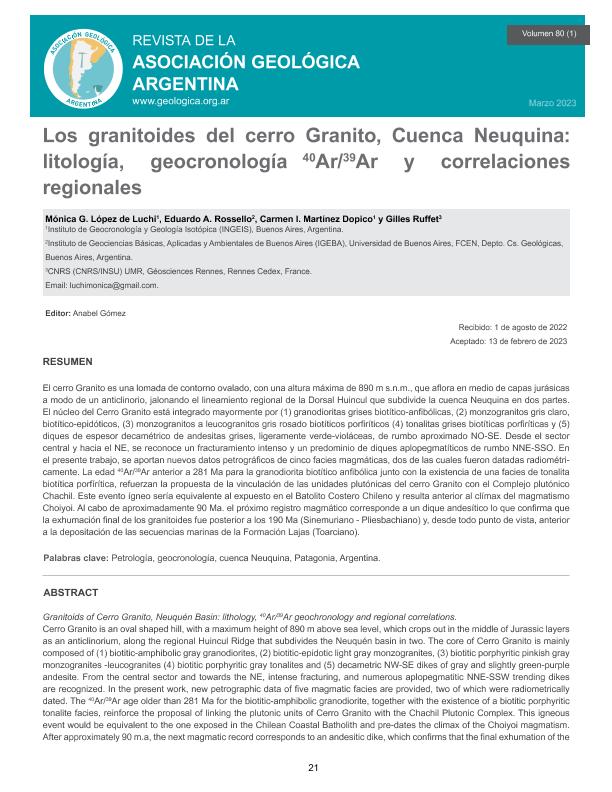Artículo
El Cerro Granito es una lomada de contorno ovalado, con una altura máxima de 890 m s.n.m., que aflora en medio de capas jurásicas a modo de un anticlinorio, jalonando el lineamiento regional de la Dorsal Huincul que subdivide la cuenca Neuquina en dos partes. El núcleo del Cerro Granito está integrado mayormente por (1) granodioritas grises biotítico-anfibólicas, (2) monzogranitos gris claro, biotítico-epidóticos, (3) monzogranitos a leucogranitos gris rosado biotíticos porfiríticos (4) tonalitas grises biotiticas porfiriticas y (5) diques de espesor decamétrico de andesitas grises, ligeramente verde-violáceas, de rumbo aproximado NO-SE. Desde el sector central y hacia el NE, se reconoce un fracturamiento intenso y un predominio de diques aplopegmatíticos de rumbo NNE. En el presente trabajo, se aportan nuevos datos petrográficos de cinco facies magmáticas, dos de las cuales fueron datadas radiométricamente. La edad 40Ar/39Ar anterior a 281 Ma para la granodiorita biotítico anfibólica junto con la existencia de una facies de tonalita biotítica porfírítica, refuerzan la propuesta de la vinculación de las unidades plutónicas del Cerro Granito con el Complejo Plutónico Chachil. Este evento ígneo sería equivalente al expuesto en el Batolito Costero Chileno y resulta anterior al clímax del magmatismo Choiyoi. Al cabo de aproximadamente 90 m.a. el próximo registro magmático corresponde a un dique andesítico lo que confirma que la exhumación final de los granitoides fue posterior a los 190 Ma (Sinemuriano - Pliesbachiano) y, desde todo punto de vista, anterior a la depositación de las secuencias marinas de la Fm Lajas (Toarciano). Cerro Granito is an oval shaped hill, with a maximum height of 890 m above sea level, which crops out in the middle of Jurassic layers as an anticlinorium, along the regional Huincul Ridge that subdivides the Neuquén basin in two. The core of Cerro Granito is mainly composed of (1) biotitic-amphibolic gray granodiorites, (2) biotitic-epidotic light gray monzogranites, (3) biotitic porphyritic pinkish gray monzogranites -leucogranites (4) biotitic porphyritic gray tonalites and (5) decametric NW-SE dikes of gray and slightly green-purple andesite. From the central sector and towards the NE, intense fracturing, and numerous aplopegmatitic NNE-SSW trending dikes are recognized. In the present work, new petrographic data of five magmatic facies are provided, two of which were radiometrically dated. The 40Ar/39Ar age older than 281 Ma for the biotitic-amphibolic granodiorite, together with the existence of a biotitic porphyritic tonalite facies, reinforce the proposal of linking the plutonic units of Cerro Granito with the Chachil Plutonic Complex. This igneous event would be equivalent to the one exposed in the Chilean Coastal Batholith and pre-dates the climax of the Choiyoi magmatism. After approximately 90 m.a, the next magmatic record corresponds to an andesitic dike, which confirms that the final exhumation of the granitoids was after 190 Ma (Sinemurian - Pliesbachian) and, from all points of view, prior to the deposition of the marine sequences of the Toarcian Lajas Formation.
Los granitoides del cerro Granito, Cuenca Neuquina: litología, geocronología 40Ar/39Ar y correlaciones regionales
Título:
Granitoids of Cerro Granito, Neuquén Basin: lithology, 40Ar/39Ar geochronology and regional correlations
Fecha de publicación:
05/2023
Editorial:
Asociación Geológica Argentina
Revista:
Revista de la Asociación Geológica Argentina
ISSN:
1853-7138
e-ISSN:
1851-8249
Idioma:
Español
Tipo de recurso:
Artículo publicado
Clasificación temática:
Resumen
Palabras clave:
PETROLOGIA
,
GEOCRONOLOGIA
,
CUENCA NEUQUINA
,
PATAGONIA
Archivos asociados
Licencia
Identificadores
Colecciones
Articulos(IGEBA)
Articulos de INSTITUTO DE GEOCIENCIAS BASICAS, APLICADAS Y AMBIENTALES DE BS. AS
Articulos de INSTITUTO DE GEOCIENCIAS BASICAS, APLICADAS Y AMBIENTALES DE BS. AS
Articulos(INGEIS)
Articulos de INST.DE GEOCRONOLOGIA Y GEOLOGIA ISOTOPICA (I)
Articulos de INST.DE GEOCRONOLOGIA Y GEOLOGIA ISOTOPICA (I)
Citación
Lopez, Monica Graciela; Rossello, Eduardo Antonio; Martínez Dopico, Carmen Irene; Ruffet, Gilles; Los granitoides del cerro Granito, Cuenca Neuquina: litología, geocronología 40Ar/39Ar y correlaciones regionales; Asociación Geológica Argentina; Revista de la Asociación Geológica Argentina; 80; 1; 5-2023; 21-36
Compartir




